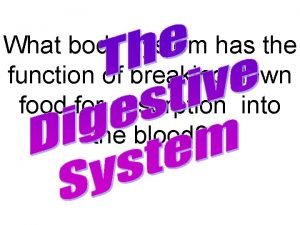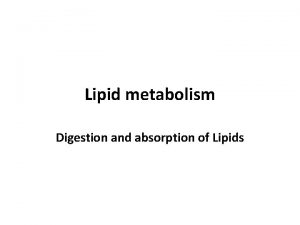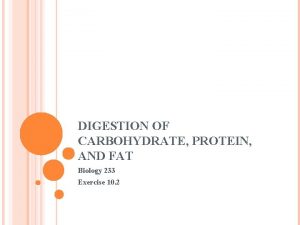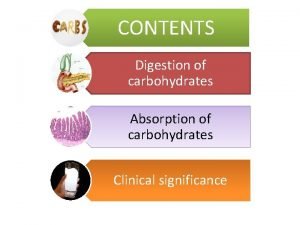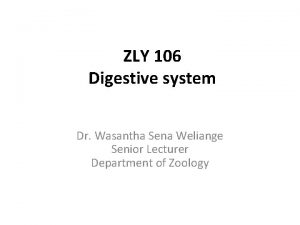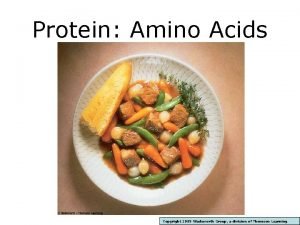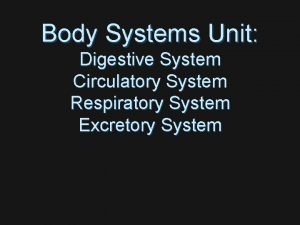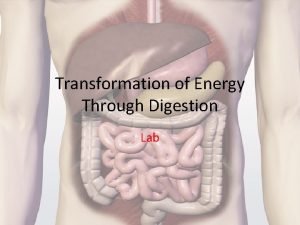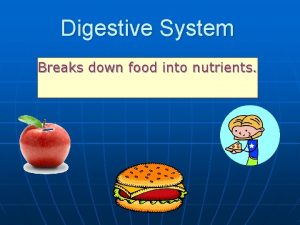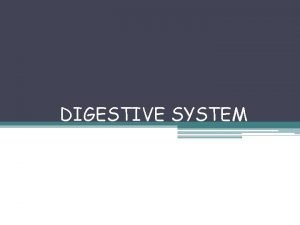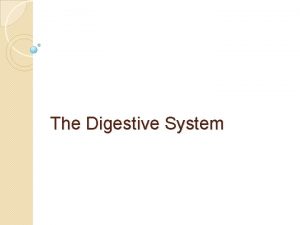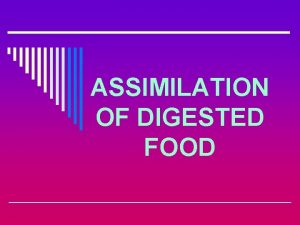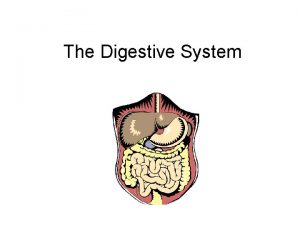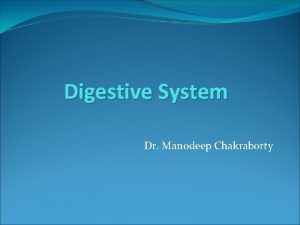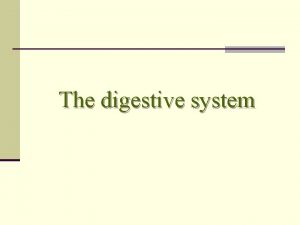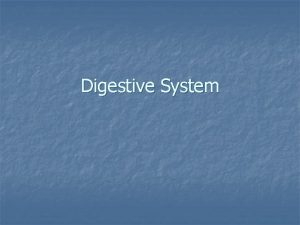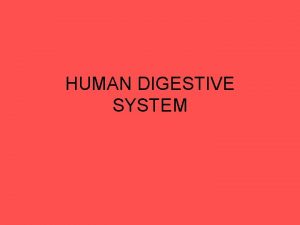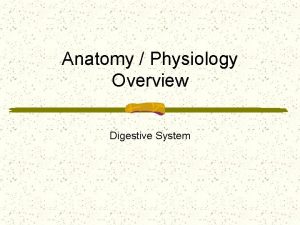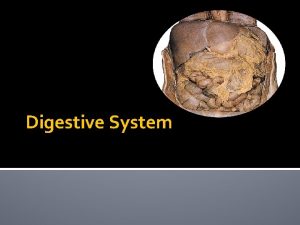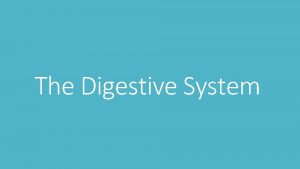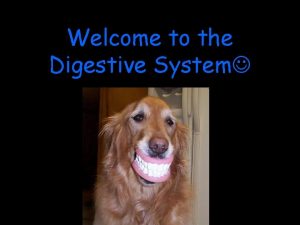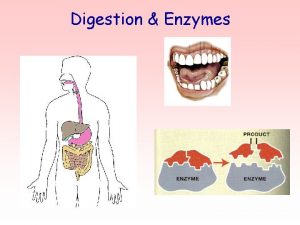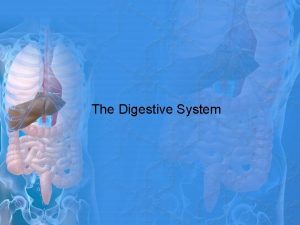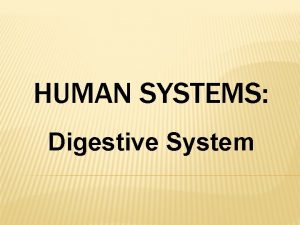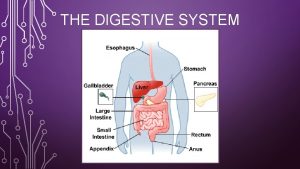The Digestive System How is food digested Digestion





























- Slides: 29

The Digestive System

How is food digested? Digestion involves: • • Breaking down of food into smaller pieces The mixing of food Movement through the digestive tract Chemical breakdown of the large molecules of food into smaller molecules. Question: What are Carbohydrates, proteins and fats broken down or digested into? Answer: Carbohydrates = Glucose Proteins = Amino Acids or AA Fats = fatty acids and glycerol • These 3 nutrients provide us with energy

Describe the Digestive system • The digestive tract is a series of hollow organs joined in a tube from the mouth to the anus. Food passes through the digestive tract. Question: Which organs make up the digestive system? Answer: Liver Gall bladder Pancreas • Food does not pass through these organs.

Identify the organs of the digestive system


Identify and tell the function of each part of the digestive system Mouth • Teeth bite off and chew food into a soft pulp that is easy to swallow. • Chewing mixes the food with saliva, from salivary glands around the mouth and face, to make it moist and easy to swallow.

Identify and tell the function of each part of the digestive system Mouth • Enzymes in the saliva begin digestion of ? Answer: Carbohydrates, such as an apple • Food is chewed up into small pieces called? Answer: Bolus

Identify and tell the function of each part of the digestive system Esophagus • The esophagus is a muscular tube. It moves food from the throat and down into the stomach. • How long does it take for food to travel to the stomach? Answer: About 5 seconds • The esophagus moves food by waves of muscle contractions called? Answer: Peristalsis

Identify and tell the function of each part of the digestive system Stomach • The stomach has thick muscles in its wall. these contract to mash the food into a paste called? Answer: Chyme Question: What kind of muscle is found in the stomach? Answer: Smooth muscle • The stomach lining produces strong digestive juices • These create chemical reactions in the stomach, breaking down and digesting its nutrients.

Identify and tell the function of each part of the digestive system Stomach Question: What is the name of the acid found in the stomach? Answer: Hydrochloric acid or HCL Question: Which chemicals help break down nutrients into the smallest molecules? Answer: Special proteins called ENZYMES

Identify and tell the function of each part of the digestive system Small Intestine • This part of the digestive tract is narrow, but very long. How long? Answer: About 20 feet • Enzymes continue the chemical reactions, or chemical digestion on the food.

Identify and tell the function of each part of the digestive system Small Intestine • The nutrients are broken down small enough to pass through the lining of the small intestine, and into the blood (diffusion). Question: What is the name of the structures where nutrients pass into the bloodstream? Answer: VILLI • Nutrients are carried away to the liver and other body parts to be processed, stored and distributed.

Actual Villi in the small intestine

Identify and tell the function of each part of the digestive system • Pancreas The pancreas, like the stomach, makes digestive juices called enzymes which help to digest food further as it enters the small intestine Question: What is the name of the enzyme that helps regulate blood sugar? Answer: INSULIN Question: What is the name of the Blood Sugar? Answer: GLUCOSE…Sweet. . !!!

Identify and tell the function of each part of the digestive system Liver “Love Your Liver”!!! • Blood from the small intestine enters the liver, carrying nutrients, vitamins and minerals, and other products from digestion. • The liver has at least …………… functions Answer: 200

Question: Name some of the important jobs of the liver? ? • Produces bile which breaks down fat • Converts glucose to glycogen • Make certain amino acids • Filters harmful substances from the blood (such as alcohol and drugs) • Stores vitamins and minerals (vitamins A, D, K and B 12) • Maintains a proper level of glucose in the blood. • Is responsible for producing cholesterol. • It produces about 80% of the cholesterol in your body.

Identify and tell the function of each part of the digestive system Gall Bladder • As food from a meal enters the small intestine, bile flows from the gall bladder along the bile duct into the small intestine. • It helps to digest fatty foods and also contains wastes for removal.

Identify and tell the function of each part of the digestive system Gall Bladder • A small baglike part under the liver. • It stores a fluid called ………………, which is made in the liver. Answer: BILE

Identify and tell the function of each part of the digestive system Large Intestine • Useful substances that were not absorbed in the small intestine, such as spare water and body minerals, are absorbed through the walls of the large intestine, back into the blood. Question: What is another name for the large intestine? Answer: COLON

Symptoms of COLON CANCER Abdominal pain and tenderness in the lower abdomen Blood in the stool Diarrhea, constipation, or other change in bowel habits Intestinal obstruction Narrow stools Unexplained anemia Weight loss with no known reason

Identify and tell the function of each part of the digestive system Rectum and Anus • The end of the large intestine and the next part of the tract, the rectum, store the feces. • Feces are finally squeezed through a ring of muscle, the anus, and out of the body.

Diseases of the Digestive Tract • Ulcers – caused by H. pylori • Cancer – high fat diets and chemicals in food • Irritable bowel syndrome - ? Stress, diet • Crohn’s disease – autoimmune problem • Cystic fibrosis – hereditary disease, defect in digestive enzymes/proteins for fats

Review Questions 1. What is Digestion? The breakdown of nutrients in food into smallest molecules for our cells to use 2. What are Enzymes? Special proteins that break down or digest nutrients into smallest molecules 3. What are the 3 important nutrients our cells need? a. Carbohydrates – pasta, bread, rice b. Fats – butter, oils, nuts c. Proteins – meat, fish, beans, nuts 4. Digestion begins in the mouth? True or False

Review Questions 5. What is Bolus? Small chunk of food chewed up in mouth, then swallowed down Esophagus 6. What is Chyme? Paste-like consistency of food in the stomach 7. What is the main job of the small intestine? To complete the digestion of food or nutrients 8. Where in small intestine do nutrients pass into the blood to be carried to cells? The Villi

Review Questions 9. How do nutrients pass into the blood? By Diffusion 10. Where is the waste or unused portion of food stored? Large intestine or Colon

On a sheet of paper, write the name of each colored organ: • • Green: Red: Pink: Brown: Purple: Green: Yellow: 26

Did you get the answers right? • • Green: Esophagus Red: Stomach Pink: Small Intestine Brown: Large Intestine Purple: Liver Green: Gall Bladder Yellow: Pancreas Great Job! 27

For more information about the digestive system, click here: http: //kidshealth. org/kid/body/digest_no. SW. html

References and Links • Your Digestive System and How It Works: http: //digestive. niddk. nih. gov/ddiseases/pubs/yrdd/Your_Digestive_Sys. pdf – Digestive system diagram comes from this site • The Real Deal on the Digestive System http: //kidshealth. org/kid/body/digest_SW_p 2. html • Pancreas: Introduction and Index http: //www. vivo. colostate. edu/hbooks/pathphys/digestion/pancreas/i ndex. html • Your Gross and Cool Body – Digestive System http: //yucky. discovery. com/flash/body/pg 000126. html 29
 Venn diagram of chemical and mechanical digestion
Venn diagram of chemical and mechanical digestion Digestive system respiratory system and circulatory system
Digestive system respiratory system and circulatory system Digestion and absorption of lipids
Digestion and absorption of lipids Carbohydrates digestion
Carbohydrates digestion Where are carbs absorbed
Where are carbs absorbed Fat is completely digested
Fat is completely digested 4 macromolecules
4 macromolecules Chemical digestion of protein
Chemical digestion of protein Pathway that food takes through the digestive system
Pathway that food takes through the digestive system Path of food from mouth to anus
Path of food from mouth to anus Nervous system and digestive system
Nervous system and digestive system Unit 2 food food food
Unit 2 food food food Sequence of food chain
Sequence of food chain What energy transformations take place during digestion
What energy transformations take place during digestion Digestion of food in stomach
Digestion of food in stomach Which is the largest gland of the body
Which is the largest gland of the body Function of gastric juice
Function of gastric juice Questron technologies corp
Questron technologies corp Picture of digestive system
Picture of digestive system Hình ảnh bộ gõ cơ thể búng tay
Hình ảnh bộ gõ cơ thể búng tay Ng-html
Ng-html Bổ thể
Bổ thể Tỉ lệ cơ thể trẻ em
Tỉ lệ cơ thể trẻ em Voi kéo gỗ như thế nào
Voi kéo gỗ như thế nào Chụp phim tư thế worms-breton
Chụp phim tư thế worms-breton Alleluia hat len nguoi oi
Alleluia hat len nguoi oi Kể tên các môn thể thao
Kể tên các môn thể thao Thế nào là hệ số cao nhất
Thế nào là hệ số cao nhất Các châu lục và đại dương trên thế giới
Các châu lục và đại dương trên thế giới Công thức tính độ biến thiên đông lượng
Công thức tính độ biến thiên đông lượng
